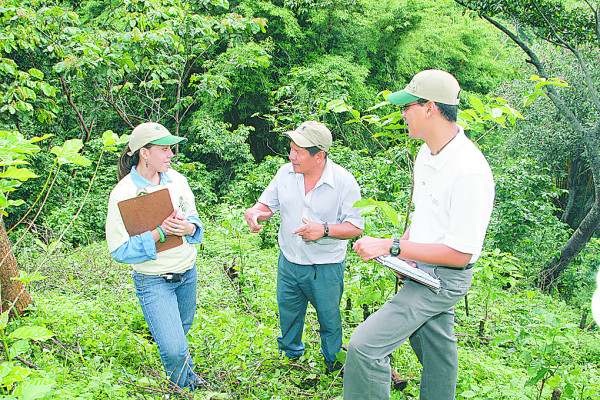
A SAN representatives meets with farmers seeking Rainforest Alliance certification. Photo by the Rainforest Alliance.
The standards used for Rainforest Alliance certification are currently being revised to be more generic and less restrictive to smallholder farmers.
The standards are maintained by the Sustainable Agriculture Network and were last updated in 2010. SAN says it wants the new standards to simplify the certification procedure for smallholder farms, which represent some 90 percent of the farms within its network. The group says the new standards should result in “ease of interpretation and scoring criteria during certification audits.”
(more: The Birds and the Bees: Coffee Quality and Yield in Tanzania)
However, some conservationists are concerned that the new standards will eliminate current requirements related to the kind of biodiversity and shade coverage that translate to sustainably produced and quality shade-grown coffee. In other words, the new requirements might belie the stated mission of the Rainforest Alliance, and mislead consumers who expect higher standards from products marked with the label.
A second and final round of public comments on the proposed revisions is open until tomorrow. So if you have opinions one way or the other, speak now or forever hold your peace.
(more: Shade-Grown Coffee Program Helping Protect Coral Reefs in Puerto Rico)
Julie Craves at Coffee & Conservation — a vital source of information on the relationship between coffee and bird habitat — digs deeper into the proposed revisions to see what has been stripped or replaced from previous versions. She writes:
Obvious shortcomings jump out:
- Requirement has gone from 40% canopy density to 20% tree cover, reduction of shade to a level that is far less beneficial to birds and other taxa. While 2.5 indicates shade density should be managed to optimal levels, it defers to local guidance, presumably given in the interpretation documents mentioned above, which are lacking for many countries, vary widely, and are not binding for certification.
- “Tree cover” is not the same as “canopy density” or “overall canopy density.” Conceivably, a farm could have a limited number of scattered trees and come up with 20% tree cover. Ecologically speaking, these terms are very different.
- The requirement is to conserve or restore a tree cover of at least 20%. What if there is already 60% cover, for example? Does this give the farm room to REDUCE tree cover (perhaps in the name of higher yield)?
- There are no strata requirements. These strata are the various “layers” of trees, seen in the shade diagram here. This type of structure is critical to biodiversity in ecosystems; the more the better.
- “12 different native tree species” is not the same as “minimum 12 native tree species per hectare on average.”
For a fuller understanding of the proposed revisions, check out more at Coffee & Conservation.
(3/18 Update: Since the publication of this article, a represent of the Raniforest Alliance reached out to Daily Coffee News with a response from the group’s standards and policy team. Below, see the response in full)
The SAN Standard strives to balance coffee productivity and optimum shade tree levels. The 40% shade level criteria of the 2010 version of the SAN Standard has proven to be a challenge in many coffee producing regions, especially areas with heavy cloud cover, high rainfall and high humidity. The proliferation of coffee rust infestations over the past few years has created additional challenges. To address new challenges such as coffee rust, farmers require some flexibility in farm management options. While the SAN and its training partners continue to strongly promote diversified shade canopies for shade-tolerant crops, it is necessary to introduce a level of flexibility in response to farm-level realities.
The proposed new approach still prioritizes on-farm tree cover, but offers farmers additional options to incorporate trees on coffee farms. These include live fences (hedgerows), riparian zones and conservation of forested areas, as well as an optimum shade level for agroforestry crops such as coffee.
Additionally, the new standard proposal includes stricter rules for continuous improvement to support progress toward non-critical criteria such as the ones mentioned. Collectively, these measures are designed to increase tree abundance and diversity on certified coffee farms.
The SAN Standard revision process is still ongoing. The SAN is very appreciative of the wealth and diversity of comments received during the latest public consultation period. Taking this feedback into account, the SAN will develop and consult stakeholders on a third draft of the standard, before preparing a final version, anticipated for the first half of 2015. The process will include a strong focus on ensuring that the new standard delivers on key ecosystem conservation outcomes.
Nick Brown
Nick Brown is the editor of Daily Coffee News by Roast Magazine.
Comment
3 Comments
Comments are closed.






Thanks for boosting the visibility of this, Nick.
Thanks for the comments, Julie, hadn’t seen this. Important, slightly disheartening things on board there. Not that their Standards were that strict to begin with…
I received the same reply on my original post, and have responded: http://www.coffeehabitat.com/2014/03/ra-shade-criteria-change/#comment-14089